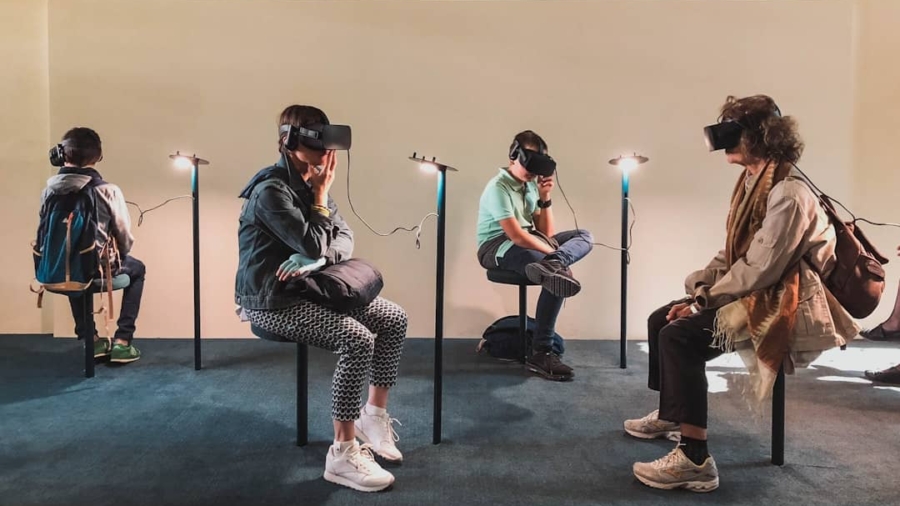Immersive storytelling is a narrative technique that envelops the audience in a multi-sensory experience, allowing them to engage with the story on a deeper level than traditional storytelling methods. This approach often utilizes various media, including virtual reality (VR), augmented reality (AR), and interactive installations, to create an environment where the audience can not only observe but also participate in the narrative. By breaking the fourth wall, immersive storytelling invites individuals to become active participants rather than passive consumers of content.
This shift transforms the way stories are told and experienced, fostering a more profound connection between the audience and the narrative. The essence of immersive storytelling lies in its ability to create a sense of presence, making the audience feel as though they are part of the story world. This is achieved through a combination of compelling narratives, rich visuals, soundscapes, and interactivity.
For instance, in a VR experience, users might find themselves in a fantastical realm where they can explore their surroundings, interact with characters, and make choices that influence the outcome of the story. This level of engagement not only enhances enjoyment but also encourages deeper emotional investment in the narrative, as individuals navigate through experiences that resonate with their own lives or challenge their perspectives.
Key Takeaways
- Immersive storytelling is a technique that uses virtual reality, augmented reality, and other immersive technologies to create a more engaging and interactive narrative experience.
- Immersive storytelling can enhance creative thinking skills by allowing the audience to explore different perspectives and scenarios in a more immersive and interactive way.
- Immersive storytelling engages the audience by creating a sense of presence and emotional connection, leading to a more impactful and memorable experience.
- Immersive storytelling can help develop empathy and perspective-taking by allowing the audience to step into the shoes of different characters and experience their stories firsthand.
- Immersive storytelling can be used as a tool for problem-solving and critical thinking by presenting complex scenarios and allowing the audience to make decisions and see the consequences in a realistic setting.
The Impact of Immersive Storytelling on Creative Thinking Skills
Immersive storytelling has a significant impact on creative thinking skills by encouraging individuals to think outside the box and explore new ideas. When participants are placed in an interactive narrative environment, they are often faced with challenges that require innovative solutions. This process stimulates divergent thinking, where multiple solutions can be generated for a single problem.
For example, in an immersive escape room scenario, participants must collaborate to solve puzzles that require creative approaches and unconventional thinking. The necessity to adapt and innovate in real-time fosters an environment where creativity can flourish. Moreover, immersive storytelling often incorporates elements of role-playing, allowing individuals to step into different characters’ shoes.
This experience can lead to enhanced imaginative capabilities as participants explore various perspectives and scenarios. By engaging with diverse narratives and characters, individuals can expand their creative horizons and develop a more nuanced understanding of storytelling itself. This exploration not only enhances their ability to generate original ideas but also equips them with the skills to approach problems from multiple angles, a crucial aspect of creative thinking.
How Immersive Storytelling Engages the Audience

The engagement factor in immersive storytelling is unparalleled due to its interactive nature. Unlike traditional narratives that present a linear storyline, immersive storytelling allows audiences to influence the direction of the narrative through their choices and actions. This interactivity creates a sense of agency, making participants feel that their decisions matter within the story world.
For instance, in an interactive film or video game, viewers may be prompted to make choices that affect character development or plot progression, leading to multiple possible endings. This level of involvement not only captivates the audience but also encourages them to invest emotionally in the characters and their journeys. Additionally, immersive storytelling often employs sensory elements that enhance engagement.
The use of sound design, visual effects, and even tactile feedback can create a rich atmosphere that draws audiences into the experience. For example, a VR experience set in a dystopian future might utilize ambient sounds of a bustling city or the distant rumble of thunder to evoke specific emotions and immerse participants fully in the environment. This sensory engagement heightens emotional responses and fosters a deeper connection to the narrative, making it more memorable and impactful.
The Role of Immersive Storytelling in Developing Empathy and Perspective-Taking
One of the most profound effects of immersive storytelling is its ability to cultivate empathy and perspective-taking among participants. By placing individuals in situations where they must navigate the experiences and emotions of diverse characters, immersive narratives encourage them to understand different viewpoints. For instance, a VR experience that simulates life as a refugee can provide users with insights into the challenges faced by displaced individuals, fostering compassion and understanding for their plight.
This experiential learning can lead to greater awareness of social issues and inspire action toward positive change. Furthermore, immersive storytelling often emphasizes emotional connections between characters and audiences. When participants engage with narratives that explore complex human experiences—such as love, loss, or conflict—they are more likely to resonate with those emotions on a personal level.
This emotional engagement can lead to increased empathy as individuals reflect on their own experiences and relate them to those portrayed in the story. By bridging the gap between different lives and experiences, immersive storytelling serves as a powerful tool for promoting empathy and encouraging individuals to consider perspectives beyond their own.
Immersive Storytelling as a Tool for Problem-Solving and Critical Thinking
The interactive nature of immersive storytelling makes it an effective tool for enhancing problem-solving and critical thinking skills. Participants are often presented with complex scenarios that require them to analyze information, evaluate options, and make decisions based on limited resources or time constraints. For example, in an immersive simulation designed for corporate training, employees might be tasked with navigating a crisis situation where they must assess risks and devise strategies to mitigate potential fallout.
This hands-on approach encourages critical thinking as individuals weigh various factors before arriving at a solution. Moreover, immersive storytelling can facilitate collaborative problem-solving by bringing together diverse groups of participants who must work together to achieve common goals. In these scenarios, individuals learn to communicate effectively, share ideas, and build consensus while navigating challenges within the narrative framework.
The collaborative aspect not only enhances critical thinking but also fosters teamwork skills that are essential in both educational and professional settings. By engaging in shared problem-solving experiences within immersive narratives, participants develop a deeper understanding of group dynamics and collective decision-making processes.
The Connection Between Immersive Storytelling and Imagination

Imagination plays a pivotal role in immersive storytelling as it allows participants to envision possibilities beyond their immediate reality. When individuals engage with immersive narratives, they are invited to suspend disbelief and explore fantastical worlds or scenarios that challenge their understanding of what is possible. This imaginative engagement can lead to enhanced creativity as participants draw upon their own experiences and ideas to navigate the story world.
For instance, in an interactive fantasy adventure game, players may need to devise unique strategies or solutions based on their imaginative interpretations of the challenges presented. Additionally, immersive storytelling often encourages participants to contribute their own narratives within the established framework. This participatory aspect allows individuals to exercise their imagination by creating alternative storylines or character arcs that reflect their personal values or aspirations.
By fostering an environment where imagination is celebrated and encouraged, immersive storytelling not only enriches individual experiences but also cultivates a culture of creativity that can extend beyond the narrative itself.
Immersive Storytelling and its Influence on Collaboration and Communication Skills
Collaboration is an inherent aspect of many immersive storytelling experiences, particularly those designed for group participation. When individuals engage in shared narratives—whether through team-based games or collaborative VR experiences—they must communicate effectively to achieve common objectives. This necessity for clear communication fosters essential skills such as active listening, negotiation, and conflict resolution.
For example, in an immersive team-building exercise set in a post-apocalyptic world, participants may need to strategize together to survive challenges while ensuring that everyone’s voice is heard. Moreover, immersive storytelling often requires participants to articulate their thoughts and ideas clearly as they navigate complex scenarios. This practice enhances verbal communication skills while also encouraging non-verbal cues such as body language and facial expressions—elements that are crucial for effective collaboration.
As individuals work together within these narrative frameworks, they learn to appreciate diverse perspectives and leverage each other’s strengths, ultimately leading to more cohesive teamwork.
Practical Applications of Immersive Storytelling in Education and Professional Development
The practical applications of immersive storytelling extend across various fields, particularly in education and professional development. In educational settings, teachers can utilize immersive narratives to create engaging learning experiences that captivate students’ attention while promoting critical thinking and problem-solving skills. For instance, history lessons can be transformed into interactive simulations where students assume roles from different time periods, allowing them to explore historical events from multiple perspectives.
This experiential learning approach not only enhances retention but also fosters a deeper understanding of complex subjects. In professional development contexts, organizations are increasingly adopting immersive storytelling techniques for training purposes. By simulating real-world scenarios—such as customer interactions or crisis management—employees can practice their skills in a safe environment before applying them in actual situations.
For example, healthcare professionals might engage in VR simulations that replicate patient interactions, enabling them to refine their communication skills while navigating challenging medical scenarios.
Through its multifaceted approach to engagement and learning, immersive storytelling has emerged as a transformative tool that reshapes how we understand narratives and their impact on human experience.
A related article to The Role of Immersive Storytelling in Building Creative Thinking Skills is “The Best Tablets for Business in 2023” which discusses the importance of technology in enhancing productivity and creativity in the workplace. To learn more about the latest tablets that can help boost your business, check out the article

